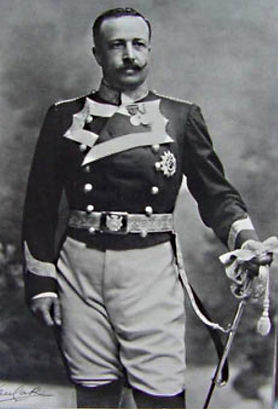
José Joaquín Álvarez de Toledo
Duke of Medina Sidonia
José Joaquín Álvarez de Toledo y Caro, 19th Duke of Medina Sidonia (28 December 1865 – 9 June 1915) was Duke of Medina Sidonia. In Madrid in 1893 he married his cousin Rosalía Caro y Caro. He was born the second son of José Álvarez de Toledo y Silva, 18th Duke of Medina Sidonia, and Rosalía Caro y Álvarez de Toledo, daughter of the 4th Marquis of La Romana. He was originally the Marquis of Molina, but on the death of his older brother Alonso, he became the heir to all the titles of the house of Medina Sidonia. He was educated in Spain, but was never interested in politics or a military career. He devoted almost his entire life to his farms in Rafol, Novelda, Molina de Segura and the pastures of Jimena de la Frontera. He managed his estate very well, but when he inherited the bulk of the family assets, he had to deal with a huge amount of debt that his father had acquired. The most urgent ones were solved with the sale of the Coto de Doñana to Guillermo Garvey, for 750,000 pesetas. As Grandee of Spain, he held important positions at court, such as Gentleman of the King's Chamber, or Chief Knight of María de las Mercedes, Princess of Asturias. He held the Collar of the Order of Carlos III, and was Master of the Real Maestranza de Caballería de Valencia.


The Royal Escort is the cavalry unit of the Spanish Royal Guard, made up of Army personnel belonging to the Cavalry Arm. Its origins are in the Royal Escort, a unit with a squadron entity, created on April 19, 1875 during the time of King Alfonso XII. From the Catholic Monarchs to the current monarch, Cavalry units have been part of the personal guard of each monarch and each head of state that Spain has had. Although the use and mission of the different mounted units of the Royal Household Troops have been similar, each reign or government has had its peculiarities and therefore its Cavalry troops. On February 2, 1852, priest Martín Merino made an attack on Queen Elizabeth II, saving her life thanks to the intervention of the halberdiers who were guarding access to the young queen's quarters. Due to this event, a new reorganization of the Royal Family troops was determined, expanding the Halberdier Guard to two companies and creating the Queen's Guard Squadron to provide protection to the queen when traveling outside the palace. On January 14, 1875, the Spanish monarchy was reinstated in the person of Alfonso XII, son of the dethroned Isabel II, and just a month later the Royal Corps of Halberdier Guards was reestablished. Months passed and the need was seen to provide the Crown with a unit that would protect the royal people in their movements outside the palace, and by Royal Order of April 19, 1875, a new body on horseback was created "to serve as escort and serve close to the Royal Persons outside the palace". This new unit,
with a Squadron entity, was called the Royal Escort. The troops were required to have served in the Cavalry Arm, have an immaculate service record, measure more than 1.74 cm and commit to 4 years of service, in addition to being under 30 years of age.

The House of Medina Sidonia (Spanish: Casa de Medina Sidonia) is a Spanish noble house originating from the crown of Castile, whose name comes from the Duke of Medina Sidonia, a hereditary noble title that John II of Castile granted to Juan Alonso Perez de Guzman, 3rd Count of Niebla, on February 17, 1445, as a reward for his services to the crown. The Dukedom of Medina Sidonia is the oldest hereditary dukedom in the kingdom of Spain. The founder of the House of Medina Sidonia was Guzmán el Bueno, since he was the one who laid the foundations on which the house would be built. His descendants accumulated possessions and titles that increased the power of the lineage, which received the definitive backing in 1445 with the concession of the Dukedom of Medina Sidonia, which in 1520 was granted the original Grandee of Spain. In addition, the house gathered and gathered other titles, such as the Lordship of Sanlúcar, the County of Niebla, the Marquisate of Gibraltar, the Marquisate of Cazaza and the Marquisate of Valverde. The House of Medina Sidonia was from its very beginning in the hands of the Pérez de Guzmán family, commonly known as the Guzmanes, until in 1779 it passed to the Álvarez de Toledo, when upon the death without descendants of Pedro de Alcántara Pérez de Guzmán y
Pacheco, 14th Duke of Medina Sidonia, it was inherited by his cousin José Álvarez de Toledo y Gonzaga, XI Marquis of Villafranca del Bierzo, who also died without descendants, passing the barony of the House of Medina Sidonia to his brother Francisco de Borja Álvarez de Toledo y Gonzaga.
Awards: Collar, sash and star of the Royal and Much Distinguished Order of Charles III, Stars of the Order of Calatrava and the Royal Cavalry Armory of Valencia.






